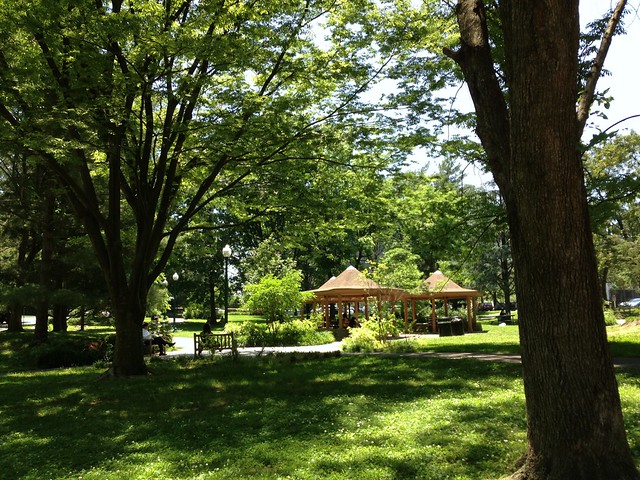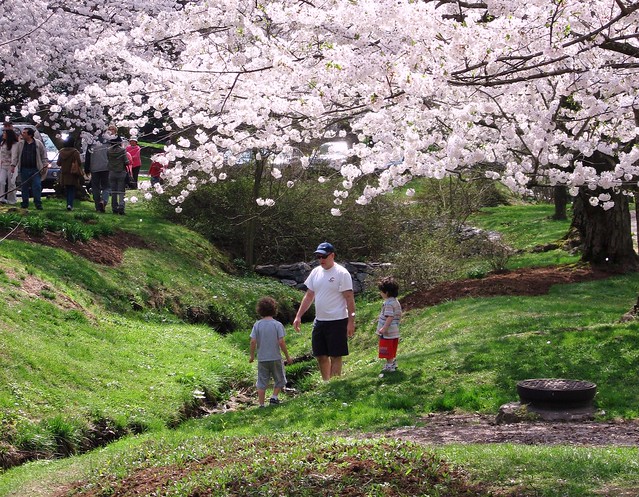The many benefits of street trees and urban greenery (excerpted from People Habitat)

Posted April 23, 2014 at 4:36PM
We humans have an intrinsic emotional need to connect with nature. The eminent biologist E. O. Wilson first called this need “biophilia,” and the term has stuck. Yet cities also, and fundamentally, need the structure of hardscape urbanism – streets, buildings, and infrastructure – in sufficient density to achieve environmental and economic efficiency and nurture social bonds. It is critical that we incorporate nature into cities, but we must do so in a way that supports urbanity rather than replaces it.
(Today’s article is excerpted from the book People Habitat: 25 Ways to Think About Greener, Healthier Cities, by F. Kaid Benfield, distributed by Island Press, 2014).
At the neighborhood scale
I remember a happy day in our neighborhood a few years back. When I came home from work, three new trees had been planted on our block. That’s a small thing, of course, just three street trees. But their predecessors had been sorely missed for a few years. When we moved into the neighborhood a little over 20 years ago, one of its major assets was large, stately street trees, most of them oaks, on nearly every block. The neighborhood was built in the 1920s, so our oldest trees would have been around 70 years old when we moved in.
Visitors are always struck by them, especially if they have come from a newer suburb. Many of those older trees remain, but over the twenty-plus years that we have lived in the neighborhood we have lost quite a few to disease and, mostly, storms. I’m sure I was not the only one whose spirits were lifted by the discovery that new ones had been planted: researchers have shown that even just a view of greenery from a window can give us a psychological and physical boost.
Indeed, for our ancestors a keen awareness of the natural environment was essential to survival. When we are deprived of nature, we lose a basic aspect of humanity. Who among us has not enjoyed a stroll, ridden a bike, read a book or magazine, learned a sport, fallen in love, taken a nap, or otherwise enjoyed the respite and communion with nature provided by a natural area or lovely city park? In cities, the presence of nature – whether interspersed among our streets, buildings and yards or more organized into parks – connects us with growth and with the seasons, providing a softness to complement the concrete of our streets and sidewalks and the brick and wood of our houses.
Among parks, I love those that are neighborhood-scaled the most. While large green spaces such as New York’s Central Park, San Francisco’s Golden Gate Park, or Washington, DC’s Rock Creek Park are wonderful, there is a more personal dimension to those that are a bit smaller, more a part of their neighborhoods. Indeed, one of my favorites is only about an acre and a half in size. It’s tucked into a neighborhood of single-family homes on small lots in Chevy Chase, Maryland, right on the boundary separating Chevy Chase from Bethesda and only a block from Bethesda’s very busy and urban main street.
Elm Street Park is so well-scaled to its neighborhood and has such beautiful large, mature trees that I go out of my way to stop there if I’m riding my bike nearby, which I do often. There are small gazebos, a playground, and scattered picnic tables but otherwise it has no special facilities. It’s just there, and I love it.
The science of urban nature and people habitat
Research suggests that I should. At the University of Michigan, a test group of students walking through an urban arboretum scored better on memory and mood indicia than a control group walking on city streets. When the roles of the two groups were reversed a week later, the students who walked through the arboretum again scored higher. The researchers suggested that the additional mental demands of with city streets – particularly attention to cars – caused stress, while in nature we can let our minds wander, enabling us to “rest our attention.”
More broadly, an academically rigorous review of 86 peer-reviewed studies published since 2000, conducted by Danish researchers for the International Federation of Parks and Recreation Administration, was published in January 2013. It found an immense range of correlations between nature and public health, from reduced headaches to longevity:
“Nature and green spaces contribute directly to public health by reducing stress and mental disorders, increasing the effect of physical activity, reducing health inequalities, and increasing perception of life quality and self-reported general health. Indirect health effects are conveyed by providing arenas and opportunities for physical activity, increasing satisfaction of living environment and social interactions, and by different modes of recreation . . .
“The direct health benefits for which we found evidence on positive effects included psychological wellbeing, reduced obesity, reduced stress, self-perceived health, reduced headache, better mental health, stroke mortality, concentration capacity, quality of life, reduced Attention Disorder Hyperactivity Disorder (ADHD) –symptoms, reduced cardiovascular symptoms and reduced mortality for respiratory disorders, reduced health complaints, overall mortality, longevity, birth weight and gestational age in low socioeconomic population, post-disaster recovery, and reduced cortisol.” [Citations omitted.]
The evidence for positive impacts of urban parks on physical activity was highlighted as “strong,” with the academically established evidence in support of other effects found to be at least “moderate.” (Conversely, when a correlation between parks and health was insufficiently established in the literature, as with the effects on lung cancer or diabetes, the authors said so.)
Another large study, reported in a monograph published by the National Recreation and Park Association in 2010 found a direct correlation between health effects and proximity of parks:
“Scientists in the Netherlands examined the prevalence of anxiety disorders in more than 345,000 residents and found that people who lived in residential areas with the least green spaces had a 44 percent higher rate of physician-diagnosed anxiety disorders than people who lived in the greenest residential areas. The effect was strongest among those most likely to spend their time near home, including children and those with low levels of education and income.
“Time spent in the lushness of green environments also reduces sadness and depression. In the Dutch study, the prevalence of physician-diagnosed depression was 33 percent higher in the residential areas with the fewest green spaces, compared to the neighborhoods with the most.”
The NRPA report even cites studies finding lower levels of aggression, violence and crime in Chicago housing projects with views of vegetation than in those without.
People intuitively appreciate these benefits and, as a result, are willing to pay a significant premium for living near nature. According to a 2006 report published by the Trust for Public Land, a review of 25 studies investigating whether parks and open space contributed to values of neighboring properties found increased value in 20 of the studies. Those benefits accrue to the municipalities as well:
“The higher value of these homes means that their owners pay higher property taxes. In some instances, the additional property taxes are sufficient to pay the annual debt charges on the bonds used to finance the park’s acquisition and development. ‘In these cases, the park is obtained at no long-term cost to the jurisdiction,’ [Texas A&M professor John] Crompton writes.”
The TPL report cites corroborating evidence from the University of Southern California, finding that investment in a pocket park in a dense urban neighborhood would pay for itself in 15 years as a result of increased tax revenues.
Environmental services provided by urban nature
Back to the trees in my neighborhood, I would love them without knowing why but, in my day job as an advocate, it’s very useful to know that science can reveal some of the reasons. Apart from what they may do for me, trees also provide measurable environmental services to their communities. If you’re interested in learning more about the benefits of trees, visit the websites of the National Arbor Day Foundation and the US Forest Service.
Among the tidbits I have discovered on one or the other of those two sites are these:
- The net cooling effect of a young, healthy tree is equivalent to ten room-size air conditioners operating 20 hours a day.
- If you plant a tree today on the west side of your home, in 5 years your energy bills should be 3 percent less. In 15 years the savings will be nearly 12 percent.
- One acre of forest absorbs six tons of carbon dioxide and puts out four tons of oxygen.
- A number of studies have shown that real estate agents and home buyers assign between 10 and 23 percent of the value of a residence to the trees on the property.
- Surgery patients who could see a grove of deciduous trees recuperated faster and required less pain-killing medicine than similar patients who viewed only brick walls.
- In one study, stands of trees reduced particulates by 9 to 13 percent, and reduced the amount reaching the ground below by 27 to 42 percent compared to an open area.
Several years ago walkability guru Dan Burden, who founded the Pedestrian and Bicycle Information Center, wrote a detailed monograph titled 22 Benefits of Urban Street Trees. Among other things, Burden calculated that “for a planting cost of $250-600 (includes first 3 years of maintenance) a single street tree returns over $90,000 of direct benefits (not including aesthetic, social and natural) in the lifetime of the tree.” He cites data finding that street trees create slower and more appropriate urban traffic speeds, increase customer attraction to businesses, and obviate increments of costly drainage infrastructure. In at least two recent studies (reported after Burden’s analysis), trees were even found to be associated with reduced crime.
Burden summarizes trees’ biological and emotional functions:
“Urban street trees provide a canopy, root structure and setting for important insect and bacterial life below the surface; at grade for pets and romantic people to pause for what pets and romantic people pause for; they act as essential lofty environments for song birds, seeds, nuts, squirrels and other urban life. Indeed, street trees so well establish natural and comfortable urban life it is unlikely we will ever see any advertisement for any marketed urban product, including cars, to be featured without street trees making the ultimate dominant, bold visual statement about place.”
That is extremely well said.
Move your cursor over the images for credit information.
This discussion is extended in People Habitat: 25 Ways to Think About Greener, Healthier Cities, distributed by Island Press and available from booksellers nationwide. Kaid Benfield writes about community, development, and the environment on Switchboard and in the national media. Today's article was first published in the Huffington Post.
Related posts:
- Your neighborhood (or mine, or anyone's) after nature's jungle takes over (March 31, 2014)
- Hamburg's ambitious green network addresses nature, climate resilience, sustainable transportation (January 10, 2014)
- How green infrastructure investments can create commercial property value (December 19, 2013)
- The coolest green infrastructure you are likely to see (November 27, 2012)
- How green infrastructure is making cities more sustainable & hospitable (October 11, 2011)
- Great short video on greening smart growth with living nature (August 17, 2009)



